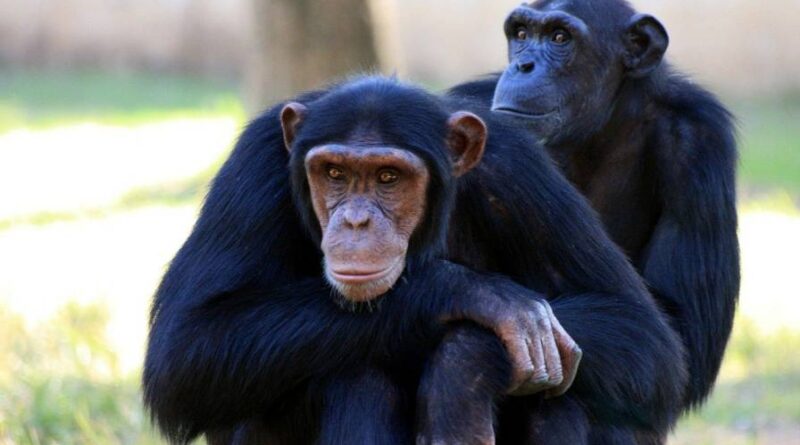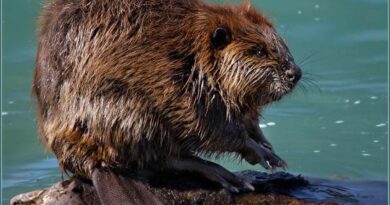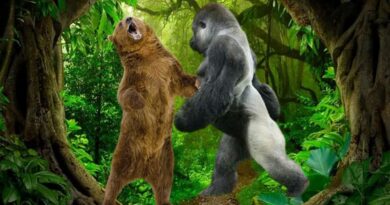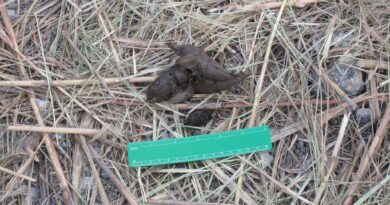CHIMPANZEE
The chimpanzee is the smartest animal that is related to us. If you give a chimpanzee a new problem, it will solve it faster than any other ape or monkey. Some people feel too close to it because it is so much like us. They find its cleverness scary because it makes them think about how close we really are to our animal friends. But they shouldn’t be worried about this because if we like and respect animals, we should be proud to be related to them.
So, what kind of animal are we most similar to? Chimps live in West Africa’s tropical forests. There, they spend most of the day searching for food as they walk around. Most of the time, they walk on all fours, using their fingernails instead of the palms of their hands. Baby chimps hold on to their mothers’ bodies when the group moves. When they are older, babies ride on their mothers’ backs.
At the first sign of trouble, the animals run up into the trees, where they are safe, and look down at the ground to see if anything is wrong. If they see a dangerous animal like a leopard coming toward them, they may run through the trees or mob it by screaming, hooting, and breaking off branches, which scare the dangerous animal away. When peace comes back, they climb back to the ground and keep looking for ripe fruits. If they find a fruit tree that is in good shape, they will stay there for a long time and eat all the sweet, juicy fruit. Overall, they eat fruit for about a third of their day. They always eat what they can find where they are, and they never store food or make larders. This is because they always have access to food of some kind.
Chimps enjoy a lot of different things. In addition to eating fruit for four hours a day, they also spend two hours a day eating tasty young leaves and shoots. They also eat flowers, seeds, nuts, and bark. They eat about a dozen different kinds of food every day. During the course of a year, they will feed over 300 different kinds of plants. For a long time, people thought that chimps only ate plants, but we now know that this is not true.
They also search for many different kinds of insects, especially termites. They use thin sticks that they push into termite hills to catch these. When the stick pokes the termites inside, they get mad and bite it with their jaws and hold on to it. The ape then takes the stick out of its mouth and quickly runs it through its lips. The termites are brushed off the stick and into the mouth of the animal, where they are swallowed neatly.
When they eat this way, the chimps first find a good stick, and then they improve it better by breaking off any small branches that stick out from it. This means they not only use tools, but also make them. Years used to say that man was different from other animals because he could make tools. We can’t claim this difference anymore.
In the last few years, scientists have learned that chimpanzees sometimes hunt, kill, and eat animals that are quite large. Monkeys, pigs, and even small antelopes have been attacked by them. A group of apes goes out in search of a victim and acts very much like a group of primitive human hunters. Some apes chase after their prey, while others corner it and kill it. The body is torn apart quickly, and the strongest apes sit and eat the meat. If they have close friends, they will share them some of it. Others may reach out their hands to beg, but they are not paid attention to. Chimps may not share food as much as wolves and wild hunting dogs do because hunting is not one of their main activities.
Another new thing we’ve learned is that wild chimpanzees have made a lot more tools than we thought. In some places, they use as many as seventeen different kinds. They have been seen using fly-whisks to get rid of bugs, large leaves as toilet paper, and hammers and anvils to give open hard shells, just to name a few examples. They have used rocks as weapons when hunting, thrown sticks at their enemies to defend themselves, and used chewed-up bark to make water sponges. There is nothing in the forest that is smarter than them.
When they aren’t feeding, the group of chimpanzees rests for a while in an open area. Now is the time to clean up, sleep, and play. It’s important for these animals to keep their fur and skin in good shape, so they spend a lot of time looking at their own bodies and the bodies of their friends. Grooming each other is a very social thing to do. It makes it possible to clean parts of an animal’s body that it can’t reach on its own, and it also helps the chimps get along better with each other.
The young apes play nearby while the adults rest. If they are very young, their mothers keep a close eye on them to make sure they don’t wander too far, get bullied, or hurt themselves.
Chimps play with a lot of energy. They chase, wrestle, play fight, and do all kinds of acrobatics. When they fight, the animals have a special face that says, “I’m not serious.” This is called a “play face.” Even though the mouth is wide open, the lips are stretched out to cover the teeth. They both make soft grunting sounds at the same time. This is their chimp version of a human smiling and laughing. It’s important for them because it keeps people from thinking that play fighting is real fighting. The chimpanzee has the most expressive face of any animal, human only to people. When nighttime comes, the chimps climb up into the trees and sleep there. But they don’t just sit on a branch and go to sleep like monkeys do. Instead, they make a special bed for themselves to sleep on.
They do this by pulling small branches toward themselves one at a time, bending or breaking them, and putting the twigs and leaves together to make a bed. When it feels good, they test it by stretching it out. If it isn’t soft or springy enough, they get back up and search for more leaves to improve to it. They are finally happy, so they go to sleep. Each baby chimp sleeps with its mother, clinging to her fur while her big arms wrap around its small body. Mothers only have one baby at a time, and that baby can sleep with her and drink her milk until she has another baby to care for after about three years.
Even so, when the new baby arrives and becomes the centre of attention, the older baby will still stay close to its mother. She will continue to care for and protect it for several more years. Chimpanzees are young for a long time, and they don’t start having animals until they are about ten years old. The biggest question about the chimpanzee today is why it has such a big brain. Why does it have to know so much? Even though their brains are much smaller, other monkeys live a similar life. They look for fruits, nuts, and seeds, live in groups, groom each other’s fur, and play in a similar way when they are young. It is hard to understand how the chimpanzee got to be so smart.
We know how smart chimps can be because we have seen them in zoos and other places where they are kept. They can be taught to work on complicated machines, for example. They can also learn simple sign language so that people can “talk” to them with their hands. They have even been able to paint simple pictures by carefully putting lines on paper in the pattern they wanted. So far, they haven’t been able to draw anything we can recognise, but their simple scribbles show that they can arrange patterns, balance designs, and keep track of a given space. It would be a big mistake to say that these apes can talk or are “artists” in the human sense, but it is clear that they are getting close.
These discoveries tell us that the chimpanzee has a great brain, but it doesn’t seem to use it much in its daily life, other than to make simple tools. One interesting idea is that chimps used to act more like humans, but now they act more like monkeys in the tropical forests. Maybe their ancestors hunted with early humans, but when they lost, they went back into the woods. Then, we humans went on to take over the world, while the apes stayed safe in their strongholds in the forest. There, they didn’t have many enemies and could enjoy a simpler lifestyle.
Now, for the first time, this way of lifestyle is in danger because there are so many humans living in tropical Africa. As the human population grows, more and more people are moving into forest areas, cutting down trees and farming on the land. It is thought that there are still between 170,000 and 300,000 chimpanzees, but that number is decreasing every year. It’s not a rare animal yet, but it could be in a few decades if farming is allowed to continue growing without any limits. If our closest living relative were to die, it would be very sad.



